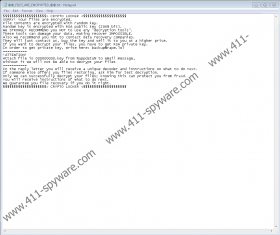Infected Ransomware Removal Guide
It could take one email or one download for the malicious Infected Ransomware to slither into your operating system. The attackers behind this malware can conceal its launcher as a harmless file, and you could be tricked into executing it yourself. Do you know which file is responsible for all of this mess? If you do, there is a good chance that you will be able to remove Infected Ransomware manually, but, of course, there is more than one way to eliminate it from the operating system, and we discuss your options in this report. We also discuss the activity of this malware, the decryptor that should be able to restore your files, and, of course, security measures you could take to ensure that your system is not invaded by this kind of malware in the future. Hopefully, you can find answers to all of your questions in this report, but if you cannot, the comments section is open.
According to our malware experts, Infected Ransomware is similar to the well-known Aurora Ransomware. In fact, these threats could be nearly identical. That is why the decryptor that Aurora Ransomware victims could use to restore their files for free should help the victims of the malicious Infected Ransomware also. When researching and installing this tool, please make sure that you do not install malware posing as a genuine decryptor. This, without a doubt, would cause even more security problems for you. That being said, a legitimate decryptor should free your personal files right up. The malicious ransomware uses an encryption algorithm to corrupt your files, and once that is done, you should find the “.infected” extension appended to the names. There is no point in removing this extension because your files cannot be restored in that manner. Even deleting the infection itself would not do anything.
The attackers behind Infected Ransomware hope that you cannot restore files from backup, so that they could trick you into paying a ransom. Three files named “@@_FILES_ARE_ENCRYPTED_@@.txt,” “@@_HOW_TO_RETURN_DATA_@@.txt,” and “@@_RECOVERY_INSTRUCTIONS_@@.txt” are created in the folders containing the corrupted files, and all of them represent the same message from the attackers. Basically, they want you to email a file named “000000000.key” that is originally located in the %APPDATA% directory. The address that the criminals are using is backup@rape.lol, and if you send them a message, they could use the opportunity to send you malware. Even if they do not do it right away, they could do it in the future. First, of course, they would ask you to pay money for a “private key” that, allegedly, is the only thing that can restore your personal files. You know that that is not the case, and so you should not even consider contacting the attackers. Focus on deleting the infection and then recovering your personal files using a trusted, free decryptor.
Since you should be able to restore your files for free, let’s focus on deleting the infection and securing your operating system. When it comes to the removal of Infected Ransomware, we highly recommend anti-malware software. Reliable software will immediately detect and erase all infections that exist, and you will not need to worry about it. Even better, the same tool will also restore your operating system, and that is a heavy burden if you decide to carry it yourself. Deleting Infected Ransomware manually could be difficult too. Unless you know where the launcher is, it is unlikely that you will be able to eliminate this threat all on your own. Note that even if you employ anti-malware software, you still need extra care when it comes to your personal files. Our researchers recommend using cloud storage or external drives to create backups. If you have backups stored outside the original location of your personal files, you will not lose files even if malware corrupts or removes them from one location.
How to delete Infected Ransomware
- Find the [unknown name].exe file that executed the threat and Delete it.
- Delete all copies of the ransom note files named @@_FILES_ARE_ENCRYPTED_@@.txt, @@_HOW_TO_RETURN_DATA_@@.txt, and @@_RECOVERY_INSTRUCTIONS_@@.txt.
- Move to the %APPDATA% directory and then Delete the file named 000000000.key.
- Empty Recycle Bin and then immediately install a trusted malware scanner.
- Perform a thorough system scan to make sure that your system is completely clean.
Infected Ransomware Screenshots:


